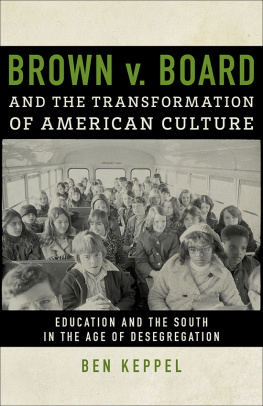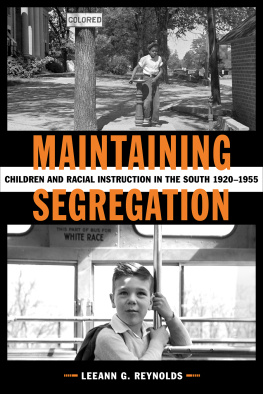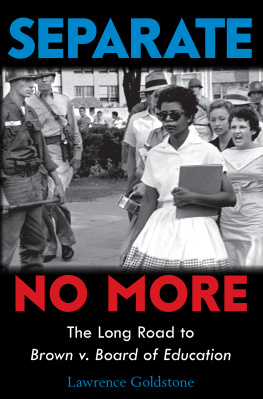Published by Louisiana State University Press
Copyright 2016 by Louisiana State University Press
All rights reserved
Manufactured in the United States of America
FIRST PRINTING
DESIGNER: Barbara Neely Bourgoyne
TYPEFACES: Brix Slab and DIN Schrift, display; Chaparral Pro, text
PRINTER AND BINDER: Maple Press
Library of Congress Cataloging-in-Publication Data
Keppel, Ben.
Brown v. Board and the transformation of American culture : education and the South in the age of desegregation / Ben Keppel.
pages cm
Includes bibliographical references and index.
ISBN 978-0-8071-6132-6 (cloth : alk. paper) ISBN 978-0-8071-6133-3 (pdf) ISBN 978-0-8071-6134-0 (epub) ISBN 978-0-8071-6135-7 (mobi) 1. United StatesRace relationsHistory20th century. 2. Popular cultureUnited StatesHistory20th century. 3. School integrationSouthern StatesHistory. 4. Brown, Oliver, 19181961Trials, litigation, etc. 5. Topeka (Kan.). Board of EducationTrials, litigation, etc. 6. Coles, Robert. 7. Cosby, Bill, 1937 8. Cooney, Joan Ganz. I. Title. II. Title: Brown versus Board and the transformation of American culture.
E184.A1K425 2015
305.800973'0904dc23
2015008670
Chapter 3 is an expanded version of an essay published previously in Race and Science: Scientific Challenges to Racism in America, edited by Paul Farber and Hamilton Cravens (Corvallis: Oregon State University Press, 2009). It is used by permission.
The paper in this book meets the guidelines for permanence and durability of the Committee on Production Guidelines for Book Longevity of the Council on Library Resources.

ACKNOWLEDGMENTS
Although this is my second book, its beginnings lead far back into my own early years. I spent my childhood and youth in Sacramento, the capital of California, at a time when educational reform and property tax relief were on a long-term, and ultimately disastrous, collision course with one another. When I began conceiving of a book about the symbolic place of children in the civil rights movement, I did not realize how close to home I would ultimately have to travel.
In my first years out of UCLA, as a history PhD working outside the academy I hoped someday to join, I was fortunate to meet Eric Gordon, who shared with me the story behind the song Black and White, which became a hit in the summer of 1972 for Three Dog Night. Eric was then in the early stages of a book on Earl Robinson, who, along with David Arkin, actually wrote that song. My appreciation for the iconography which suffuses American discussions of race was made deeper by Franklin U. D. Westbrook, a graphic artist who also became a friend while he, Eric, and I worked together at the Social and Public Art Resource Center in Venice, California.
The archival research for this book began nearly twenty years ago in Birmingham, Alabama; Washington, D.C. (and College Park, Maryland); and Fayetteville, Arkansas. The research was funded by one of two Junior Faculty Research Grants that I received from the College of Arts and Sciences (of which Paul B. Bell was an outstanding dean) at the University of Oklahoma, where I started my career as a tenure-track faculty member. As the number of these positions falls every year, I am reminded that this book might never have been completed had I not been fortunate enough to land at the University of Oklahoma in 1994. The Arts and Sciences Committee on Teaching and Research also made it possible for me to present parts of this research before audiences at the annual meetings of the Mid-America Conference on History, the Organization of American Historians, the American Historical Association, and the Society for the Study of the History of Children and Youth.
My location at the University of Oklahoma no doubt helped me obtain early support from the National Endowment for the Humanities and the Rockefeller Archive Center. In addition, I was able to work with administrators such as Lee Williams and Kelvin Droggemeyer, who supported my occasional needs for reasonable accommodation as I traveled to present papers and do research without ever having to be reminded of the Americans with Disabilities Act. I am also forever grateful to John M. Rhea and Sara Eppler-Janda, who helped find and copy a dizzying array of articles for me in the years before the arrival of the digital age.
Archivists are the historians indispensible partners, and I owe a debt to several of these skilled professionals. As the focus of my work matured and changed over time, Lin Fredricksen (Kansas State Historical Society), Jim Baggett (Birmingham Public Library), Joan Barker (Topeka High School Historical Society), Jeffrey Bridgers (Library of Congress), Anna Cartier (John F. Kennedy Presidential Library), Faith Coleman (Ford Foundation Archives), Bryan Giezma and Tim Hodgdon (University North Carolina, Chapel Hill), Brenda Hearing (Carnegie Corporation Papers, Columbia University), Jennifer Mandel (Ronald Reagan Presidential Library), and Robert W. Morrow (Public Broadcasting Archives, University of Maryland), Rick Pifer (Wisconsin State Historical Society), Anne Marie Rachman, David Cooper, Peter Berg, and Ben Dettmar (Michigan State University), and Rosemarie Truglio (Childrens Television Workshop Video Archives, New York City) often found ways to help me extend my reach beyond what my budget of time and money would allow.
At the University of Oklahoma, H. Wayne Morgan took my wife, Katherine A. Pandora, and me under his strong and capacious wing and mentored us through some very difficult times at the university. I have worked with three departmental chairs, and, of these three, Morgan had the toughest job, helping me in my first semester of teaching, which included an introduction to the institutional procedures associated with academic misconduct by students. (If I had been told back in late 1994 that I would not need round-the-clock psychiatric care after twenty years of handling such issues with a relatively small number of offenders, I would not have believed it. Waynes advice is the main reason I can laugh about that now.) Rob Griswold picked up where Wayne left off, providing consistent encouragement and support as I worked on this book while juggling too many other things. Jamie Hart, who currently chairs our department, has continued this tradition.
The vast majority of my students at the University of Oklahoma have given me thousands of reasons for optimism and hope for the future. To the extent I now see the civil rights years as a flawed collective experiment in an often unwilling process of historical reenactment, it is because rich and lively conversations with students over the last twenty years have made me see this truth much more clearly.
This book is better because of the friendship and good advice of several colleagues I am honored to also count on as friends. Michael Alexander (now a faculty member in the Religious Studies Program at the University of California, Riverside) read some of my first work on this manuscript. Much later, I sought and promptly received the wisdom of other colleagues at Oklahoma and elsewhere: David Chappell, Hamilton Cravens, Paul Farber, Rob Griswold, Sandie Holguin, Catherine E. Kelly, Kathryn Schumaker, and Werner Sollors offered sound advice at key points. To this group, I am proud to add Fay Yarbrough, whom I met for the first time while we were both presenting papers at a conference at Oregon State University in the spring of 2006. I will always be grateful that she joined our department for an important seven years in its history before she returned to teach at her undergraduate alma mater, Rice University.






